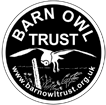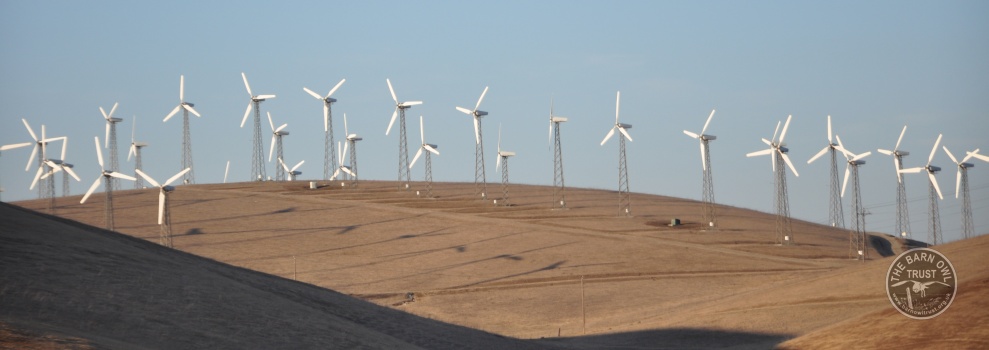Wind turbines and Barn Owls
We are often contacted by people who are concerned about the effect of wind turbines on their local Barn Owl population.
Do wind turbines kill Barn Owls?
The short answer is hardly ever. There has been only one* confirmed case of a Barn Owl being killed by a wind turbine in Britain (Cumbria – 04/01/13) and this was a small domestic turbine, not a tall commercial one. Overall there is no evidence that wind turbines have a significant impact on Barn Owls in the UK.
*Two more recent cases are awaiting confirmation.
For many years we have monitored a site with nesting Barn Owls and a small/medium-sized wind turbine (see photo). In a 10-year period:
- Barn Owls nested successfully 6 times within 500 metres of the wind turbine.
- …and nested successfully only 35 metres from the turbine for a further 3 years.
- An average of 3 young have been produced per year with no reported casualties.
We have also recorded a site where Barn Owls have nested successfully at least 6 times, only 750 metres from a wind farm comprising 16 massive turbines.
Why are Barn Owls so rarely affected by wind turbines?
- Barn Owls hunt at low levels (in order to hear their prey) – typically less than 3 metres above the ground.
- Most wind turbine blades have a ground clearance well above 3 metres.
- It is possible for birds to fly through rotating wind turbine blades unharmed.
- A wind turbine is not like a powered propeller: it does not ‘suck in’ and shred birds.
Although fatalities caused by wind turbines are likely to be under-recorded due to scavenging of corpses, this is also true of many other death-causes that are recorded such as starvation or flying into overhead wires.
Planning wind farms for Barn Owls
Ways to minimise any potential risks from wind farms to Barn Owls and other birds
- Proposals for new wind farms should include a full Environmental Assessment.
- This should include the close monitoring of the movements of high-flying bird species for a full 12 months.
- Tubular turbine masts should be preferred over lattice masts – to reduce the risk of Barn Owls attempting to use the structure for perching.
- Where the bottom of the rotor arc is within 5 metres of the ground, vegetation surrounding the turbines should be managed specifically to reduce the availability of small mammals to birds of prey.
- Wind anemometers are often a temporary pre-cursor to wind farm applications.
- Wind anemometers are potentially more dangerous than turbines, due to their stabilising wires – up to 20 wires per mast.
- Barn Owls can be at risk of flying into wires, especially where they are positioned in prime foraging habitat.
- Possible preventative measures include white-coated wires, fitted with sound generating devices such as ‘humming lines’.
Monitoring any impact by wind farms on Barn Owls, birds and bats
- Monitoring at wind turbine/anemometer sites for Barn Owl injuries/fatalities is currently inadequate.
- Without consistent monitoring, mortality may be under-recorded.
- The simplest form of monitoring involves regular intentional searches for bird carcasses.
- However, the probability of dead birds being found is reduced by their removal by scavengers.
- Carcasses may also be accidentally overlooked if not deliberately searched for, especially if they are not immediately underneath turbines.
Recommendations for monitoring wildlife fatalities at wind farms
- Given the likely proliferation of wind turbines, a strong argument exists for long-term (ideally independent) monitoring systems to be implemented at wind turbine sites.
- New major wind farm developments should be surrounded by Fox and Badger-proof fencing to prevent scavenging of dead birds.
- Fences should be positioned away from the mast base(s) in all directions.
- Fences should be at a distance that is no less than the height of the mast plus the length of one blade.
- The fenced area must be systematically searched for dead/injured birds and bats no less than once a week at all times of the year, for no less than 2 years.
- Monitoring results should be made public.
- Local Planning Authorities (LPA) should ensure that adequate monitoring is required as a planning condition, in line with a statement by the Minister for Energy and Climate Change. (See PDF for details)
Barn Owl Trust Wind Turbine Position Statement
- We view climate change as a serious threat to wildlife and therefore support the government’s intention to increase the UK’s renewables portfolio in an effort to reach net zero emissions by 2050.
- Although we are not opposed to wind farms, the Barn Owl Trust would not hesitate to oppose a proposed development if we believe it posed a significant risk to local Barn Owls.
- If you or your organisation discover any evidence of a wind turbine having a detrimental effect on a Barn Owl (or Barn Owl site occupation) please Contact Us.
How wind farms got a bad reputation: the Altamont Pass Wind Resource Area, California
The Altamont Pass Wind Resource Area is a huge, very poorly positioned wind farm in California that has killed numerous birds of prey. It consists of a large number of small turbines, which are being replaced by newer, more bird-friendly models. The Altamont Pass study involved the American Barn Owls, (Tyto furcata) which, unlike British Barn Owls, are partially migratory. Although some Barn Owl deaths were recorded over the course of the study, they equate to only one death per turbine every 53 years. This level of impact is in sharp contrast to other hazards, such as major roads, which kill thousands of Barn Owls every year.
Barn Owls and wind farms, a summary
- There is no evidence that wind farms have a significant impact on Barn Owls in the UK.
- Wind turbines that sometimes kill birds are usually poorly positioned.
- Any victims are usually high-flying species rather than low-flying birds like Barn Owls.
We keep detailed records of reported Barn Owl deaths, as well as live sightings, from across the UK.
Please report your Barn Owl sighting
Report a dead and/or ringed owl

![Domestic Wind Turbine Devon Fowlescombe Wind Turbine [David Ramsden] 220211(B) 002](https://www.barnowltrust.org.uk/wp-content/uploads/domestic-wind-turbine-devon.jpg)
![Bears Down Wind Farm In Cornwall Aerial Bear Down Wind Farm 3 [David Ramsden] 211010(B)](https://www.barnowltrust.org.uk/wp-content/uploads/Bears-down-wind-farm-in-cornwall.jpg)
